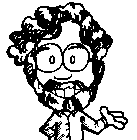Designing for Wide Walls
This essay was originally published in Design.blog in August 2016
When discussing technologies to support learning and education, my mentor Seymour Papert (who, sadly, passed away last month) often emphasized the importance of “low floors” and “high ceilings.” For a technology to be effective, he said, it should provide easy ways for novices to get started (low floor) but also ways for them to work on increasingly sophisticated projects over time (high ceiling). With his Logo programming language, for example, kids could start by drawing simple squares and triangles, but gradually create more complex geometric patterns over time.
But the most important lesson that I learned from Seymour isn’t captured in the low-floor/high-ceiling metaphor. We need to add an extra dimension: wide walls. It’s not enough to provide a single path from low floor to high ceiling; we need to provide wide walls so that kids can explore multiple pathways from floor to ceiling.
Why are wide walls important? We know that kids will become most engaged, and learn the most, when they are working on projects that are personally meaningful to them. But no single project will be meaningful to all kids. So if we want to engage all kids — from many different backgrounds, with many different interests — we need to support a wide diversity of pathways and projects.
Wide walls has become a guiding design principle for my Lifelong Kindergarten research group at the MIT Media Lab. As we develop our Scratch programming language, for example, we explicitly design it so that kids can create a wide range of projects — not just games, but also interactive stories, art, music, animations, and simulations. And as we develop and introduce new robotics technologies, our goal is to enable everyone to create projects based on their own interests — not just traditional robots, but also interactive sculptures and musical instruments.
We had similar goals when we co-founded the Computer Clubhouse project, a network of after-school centers for youth from low-income communities. We set up the Clubhouses to support a wide range of activities. Kids at Clubhouses create music videos, interactive jewelry, animated stories, and just about anything else they can imagine. At one point, we hosted a visit from a major Silicon Valley company that was interested in diversifying the pipeline of people moving into its workforce. When they saw the activities in the Clubhouse, they were skeptical at first. Why so much emphasis on art and music? The company wanted people with expertise in math, science, and technology. We explained that it is important to build on kids’ interests and passions. When kids work on projects care about, they’re willing to work longer and harder, persist in the face of challenges, and make deeper connections to the ideas that they encounter. The company ended up supporting the Clubhouse program for many years.
It was our experiences at Computer Clubhouses that motivated our work on Scratch. We saw that Clubhouse members wanted to create their own interactive stories, games, and animations, but existing tools and languages weren’t designed with Clubhouse members in mind. As we started to develop Scratch a decade ago, we tested each round of prototypes at Clubhouses, getting constant feedback and suggestions from Clubhouse members. We found that tools developed for the diverse collection of youth at Clubhouses also appealed to many others. The Scratch website now attracts more than 10 million unique visitors each month — and 20,000 new Scratch projects are shared on the site every day.
In evaluating the success of our technologies, activities, and learning environments, one of our main criteria is the diversity of projects that people create. If the projects are all similar to one another, we feel that something has gone wrong. The walls were not wide enough. If we see a wide variety of projects, we take it as an indication that everyone had an opportunity to follow their own interests and become deeply engaged.
Our ultimate goal is to help all kids develop their thinking, develop their voices, and develop their identities. None of that will happen unless we continually ask: Who are we including? Who are we excluding? And how can we provide everyone — everyone — with opportunities for exploring, experimenting, and expressing themselves.
